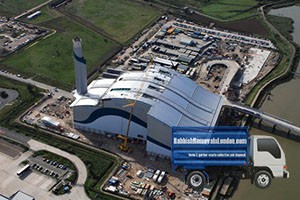This is a continuation of the list of hotly debated and turbulent incinerator projects proposed for construction in and around London. As mentioned earlier, burning junk and rubbish from homes and businesses is not the best waste management solution in the world, but it is a much better alternative to landfills or similar rubbish management practices – at least it creates power and heat if anything.
Willesden Junction EFW Plant, also known as ACTF or Willesden Junction Freight Terminal Site is a hundred and twenty eight thousand ton pyrolysis incinerator. When in use, it is expected for the incinerator to generate eight megawatts of power through ACT which stands for advances combustion technology. Planning permission has not been granted yet (although submitted in twenty twelve) as the proposed incinerator site could end up being part of the London High Speed 2 Project. So far, there is no further processing of the application, though the project is not cancelled.
Sutton Waste Management Facility in South London is going to be a decent sized junk and rubbish incinerator with a two hundred and seventy five thousand ton processing capacity. Planning permission for the facility was given in twenty thirteen. The incinerator is intended to be a long-term municipal waste management facility chiefly serving the boroughs of Merton, Sutton and Kingston.
Another junk and rubbish incinerator in South London is the still-nameless site known as Rear of 87 Beddington Lane. This is likely to be a gasification type incinerator with hundred and fifty thousand ton waste processing capacity. It is expected to be an Advanced Thermal Treatment facility – a special type of incinerator processing biomass waste and low-grade waste wood. Planning permission for the facility was given in twenty fourteen, however this has nothing to do with the other waste processing plant due for construction in the same district.
 One of the South East London waste processing sites to be in operation already is the Belvedere Incinerator. The treatment plant has quite a formidable processing capacity – seven hundred thousand tons. Belvedere Incinerator was one of the first to be funded and constructed through the EfW (energy for waste) Initiative. The site operator has signed a twenty five year contract with local authorities to treat up to seventy thousand tons of residual waste per annum. Up until three years ago, the plant had burnt nearly four hundred thousand tons of junk and rubbish.
One of the South East London waste processing sites to be in operation already is the Belvedere Incinerator. The treatment plant has quite a formidable processing capacity – seven hundred thousand tons. Belvedere Incinerator was one of the first to be funded and constructed through the EfW (energy for waste) Initiative. The site operator has signed a twenty five year contract with local authorities to treat up to seventy thousand tons of residual waste per annum. Up until three years ago, the plant had burnt nearly four hundred thousand tons of junk and rubbish.
SELCHP is South East London, also known as the Kennels Site, is operated by South East London Combined Heat & Power Ltd. (SELCHP). The incinerator has nearly half a million ton processing capacity and has been in operation since two thousand six. From two thousand six, to two thousand nine alone, the facility had burnt nearly five million tons of waste.
Tate & Lyle Sugar Refinery Site in East London is also the proposed location of a rubbish incinerator operated by a company called Covanta. The facility which is to have about three hundred thousand tons of processing capacity is expected to be a SRF burning incinerator. At his point there are quite a few issues and complications with permits, application withdrawals etc. concerning the project.

